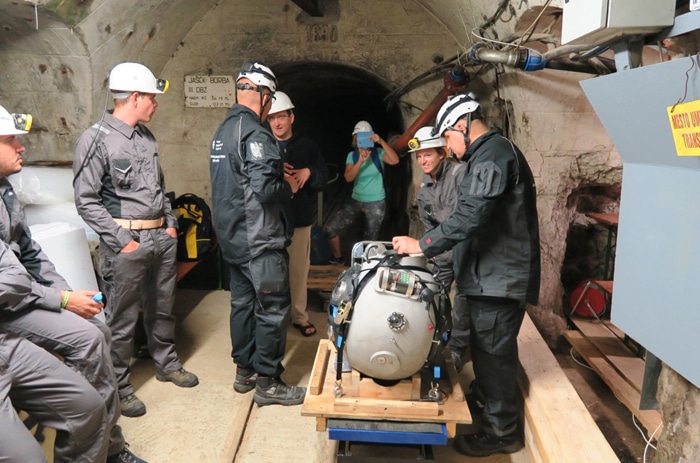Jul 10 2019
An international team of scientists, including scientists from Universidad Politécnica de Madrid (UPM), is creating a new tool that will enable scientists to investigate and appraise mines so as to learn if it is economically feasible to re-open them.
 The UX-1a prototype ready to be released during the field tests in the mine from Idrija (Slovenia). (Image credit: UNEXMIN project)
The UX-1a prototype ready to be released during the field tests in the mine from Idrija (Slovenia). (Image credit: UNEXMIN project)
The Centre for Automation and Robotics (CAR), a joint center of UPM and CSIC, is involved in the UNEXMIN European project to build an autonomous underwater robot that investigates abandoned mines, many of them over one century ago. The geological information gathered by onboard devices together with the tunnel maps rebuilt by the robots is vital to resolve if it is economically feasible to reopen these mines.
There are about 30,000 closed mine sites across Europe, a number of them can have beneficial raw materials. Europe has a virtually full dependency on the import of mineral raw materials and some of these materials are in great demand. However, these mines are presently flooded and their most recent status information is from several years ago.
The closure of these mines was usually connected with technological challenges more than the concrete presence of mineral resources. A majority of these old mine sites are currently flooded, and the information available concerning the structural layout of the tunnels is incomplete or imprecise. Furthermore, exploration by human divers is ruled out because of the dangers involved, and de-watering without a priori knowledge of the mineralogical composition is not feasible owing to its high costs.
In the 2012 movie Prometheus by Ridley Scott, explorers land on the LV-233 planet and discover strange alien structures, then they release spherical drones to reconstruct a structural mapping, and identify potential hazards. After they got the map, they could move safely through the unfamiliar structure.
“The aim of the UNEXMIN project is to design and develop similar drones but, in this case, for underwater use,” Claudio Rossi, a CAR-UPM-CSIC scientist involved in this project explains.
UNEXMI drones will investigate peculiar and unfamiliar structures, that is, flooded underground landmines. The first underwater robot created in this project, called “Robotic Explorer” (UX-1a), is able to autonomously navigate in the intricate tunnels of these mines and rebuild a map of the structures to evaluate their composition and the probable presence of raw materials.
The spherical-shaped robot offers better stability and less danger in the tunnels. This robot is fitted with five digital cameras and rotating laser line projectors for structured light systems. It is also fitted with a multispectral camera, a water sampling system, and a unit for measuring gamma radiation.
From a technological point of view, this project is facing three main challenges: the first one is to build a robot which is able to work in real underwater environment up to 500 meters (it has been already tested in mines located in Finland, Slovenia, and Portugal).
Claudio Rossi, Scientist, CAR-UPM-CSIC
Rossi continued, “The second challenge is to achieve autonomous navigation in unknown environment, since there is no communication with the outside, and finally, the third challenge is to develop ad-hoc scientific instrumentation to assess the geophysical information.”
UNEXMIN project will build a state-of-the-art robotic system for exploration and autonomous mapping of flooded mines in Europe. Also, the UX-1 robot will use non-invasive procedures of 3D mapping to gather beneficial mineralogical and geological information. This will help create new scenarios to make tactical decisions about reopening abandoned mines in Europe.